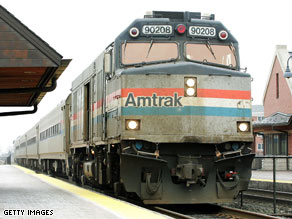
Here is a breakdown of who gained, who lost and who survived in the final economic stimulus bill that the House and Senate are expected to vote on Friday:
Winners High-speed and inner-city rail: Went from $300 million in House bill to $2.25 billion in Senate to $8 billion in final version. There also is a $6.9 billion provision for public transit. Amtrak: Picked up $500 million from both House and Senate versions to total $1.3 billion. The bill stipulates that no more than 60 percent can go to the Northeast Corridor. National Institutes of Health: Ends up with $10 billion in the final bill. The House proposed $3.5 billion and the Senate wanted $10 billion — $8.2 billion goes to the NIH director for his discretion. Government oversight: Board to oversee stimulus bill spending will get $84 million to do the job. House bill allocated $14 million while the Senate bill called for $7 million. There is also more than $100 million more for various inspectors general in different agencies. NASA: Banked just more than $2 billion, including $400,000 for science/global-warming research. Watch congressional comments on the stimulus bill »
CNN Money Summit
Ali Velshi and sharpest minds in money dissect the economic stimulus bill.
Tuesday, 11 p.m. ET
see full schedule »
Losers Veterans: Nearly all items for Veterans Affairs were reduced and the $2 billion the Senate wanted for VA construction was wiped out altogether. The VA did get one thing: $1 billion for medical facilities renovation and retooling. Military construction: Cut and put into a general pot, a change from targeted money for each branch of the services. Army construction alone went from $600 million in the Senate and $900 million in the House to $180 million in the final bill. But negotiators compromised over a general military construction fund — the House wanted $3.75 billion while the Senate allocated $118 million and settled on $1.45 billion for all services. FBI: Senate had allocated $475 million but all was cut out of final bill.
Don’t Miss
Obama makes 11th-hour stimulus push
House, Senate to vote on stimulus bill
In depth: The 44th President
Survivors Pandemic flu research: Although senators agreed it wouldn’t produce jobs, it’s getting $50 million in the final bill, down from nearly $900 million. Watch the latest on the stimulus bill » Damage control Foreclosures: $2 billion is set for a neighborhood stabilization program that helps areas plagued with foreclosures by buying back properties and preventing blight. Homeless: $1.5 billion is directed to homelessness prevention. Passports: $90 million is going to the State Department to deal with domestic facilities that deal with passports and training. Social Security: $500 million goes to replace its 30-year-old computer system. Tax breaks Car buyers: Anyone who buys a new car in 2009 gets to deduct the sales tax. To qualify, buyer must make less than $125,000 individually or $250,000 jointly. Cost is $1.7 billion. Homebuyers: First-time homebuyers who purchase this calendar year get an $8,000 tax credit which does not have to be repaid like a similar measure last year. This phases out for people making more than $75,000 individually or $150,000 jointly. “First-time homebuyer” is defined as someone who has not owned a home for the past three years. Cost: $6.63 billion. Paying for college Pell grants: will increase to a maximum of $5,350 per student in 2009-2010 year thanks to two provisions in the stimulus. Tax credits: Individuals making less than $80,000 or families making less than $160,000 can get up to $2,500 in tax credits for college tuition. 40 percent ($1,000) of the credit is refundable. Cost: $13.9 billion over 10 years.
Making work pay Tax credits: Anyone making $75,000 individually or $150,000 as a family will get refundable tax credit up to $400 per person or $800 per family.